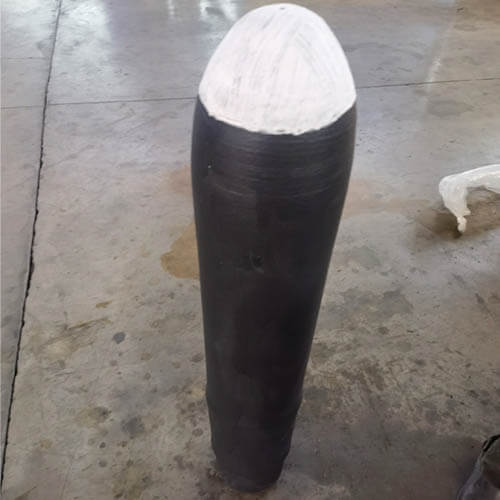Stopper rods are shaped refractory materials used in continuous casting processes. They maintain mold level stability, control the linear flow rate of molten steel, and guarantee both surface and internal quality of the ingot. In actual production, stopper rods play a crucial role in maintaining stable steelmaking operations. Problems with the stopper rods, such as erosion, breakage, and nodules, can cause excessive fluctuations in the mold steel level, leading to premature shutdown or forced downtime of the continuous casting machine.
Analysis of stopper rod fracture problem
A steel mill’s slab continuous casting machine frequently experienced stopper rod breakage during casting, seriously impacting normal production. Accident statistics showed that 20% of the stopper rods fell off during tundish baking or casting. The remaining cases involved the stopper rods falling off or breaking 650-700mm below the top edge during casting, with a V-shaped fracture (see Figure 1). Statistics show 12 stopper rod accidents occurred in 2021, an average of one per month. Each incident resulted in unplanned downtime for the continuous casting machine, requiring re-baking of the tundish, reconditioning, and re-casting, disrupting normal production schedules. Consequently, a solution to the stopper rod problem was urgently needed to stabilize continuous casting production and reduce cost losses.
Through statistical classification of stopper rod accidents, it is believed that the main factors affecting stopper rod breakage and stopper rod head falling are thermal shock, strength and stopper rod design and installation problems.
1.Thermal shock issues
Analysis of the plug rod body and head material design, along with the manufacturing process, indicates that the currently used plug rod material meets process requirements. The steel mill primarily uses carbon structural steel, high-carbon steel, and some medium-carbon alloy steel, which cause minimal erosion to the plug rod. The plug rod lacks a slag line design, and erosion at the plug rod head is not severe. During normal 15-hour steel pouring, the plug rod head maintains good flow control with uniform erosion, confirming that the material design is fundamentally sound. Examination of the fracture surface from the broken plug head reveals a clean, flush break at the 50–60 mm position. The primary issue to address is plug manufacturing. Adjustments and enhancements to the production process are required. The direct cause of plug fracture is stress resulting from inconsistent raw material composition used in manufacturing.
Monitoring of ladle baking operations at the site indicates low baking efficiency. Baking utilizes converter gas with a typical calorific value of 1300 × 4.1868 kJ/m³. The baking duration is 3 hours, conducted with the stopper rod open at 1000°C. The ladle remains uncovered during baking, resulting in significant flame overflow. Poor baking results in uneven thermal stress distribution within the plug’s refractory material, leading to micro-cracks. During casting, the plug operates under extreme conditions where even minor defects are amplified.
2.Strength issues
Stopper rod fractures at the slag line typically occur one to two heats after changing the nozzle during steel pouring, after bonding is restored, or during a quick tundish change. Analysis suggests that cracks and subsequent fractures occur when the stopper rod is closed during the steel pouring process, subject to lateral and longitudinal forces.
Analysis of the stopper rod’s strength revealed that its strength is relatively low in the hot state, making it susceptible to fracture under molten steel erosion or stress. Strengthening of the stopper rod is necessary.
3.Design and installation of stopper rod
Tracking the installation of the stopper rod on site revealed the following analysis: ① Problems with the stopper rod design. When the stopper rod was open, it protruded 200mm above the tundish cover. Normally, a 50mm protrusion would meet the design requirement. However, the stopper rod was too long. When closing the stopper rod in an emergency, it was subjected to significant external forces, making it prone to breakage. This was particularly true at the slag line, where the stopper rod diameter changes and is particularly vulnerable. ② Problems with the stopper rod installation occurred. This was primarily due to the stopper rod being installed offline, potentially causing damage during the tundish on-line process. The stopper rod installation requires a “bite” (a “head”), which generated lateral forces when closing the stopper rod, causing cracks in the stopper rod head or in weaker areas of the rod. When closing the stopper rod during the steel pouring process, the operator switched the mode from automatic to manual and then forcefully pressed the handle to close the stopper rod, further exacerbating the damage.

Improvement Measures
1.Improvement of stopper rod fracture problem
To address the aforementioned issues, improvements to the currently used stopper rods are proposed, with the specific plan outlined below:
(1) While meeting production requirements, fine-tune the material composition to moderately enhance the plug rod’s thermal shock resistance and reinforce the neck strength. The adjustment approach involves introducing SiC micropowder into the ladle plug rod production mix, focusing on the plug head and slag line areas. A composite structure design was implemented to improve the plug rod’s overall mechanical properties while reducing its linear expansion coefficient. With 5% SiC micropowder addition, the magnesium-carbon plug head material exhibits room-temperature and high-temperature flexural strengths of 8.2 MPa and 9.4 MPa, respectively. The average linear expansion coefficient is 7.1×10⁻⁶/°C. After three thermal shock cycles at 1100°C, no significant cracks were observed.
(2) Plug rod length adjustment. The current plug rod length of 1750 mm increases manufacturing complexity and amplifies lateral forces generated by molten steel flow during operation, leading to rod fracture under stress. Based on field conditions, the plug rod length was adjusted to 1650 mm.
(3) Optimize the plug head design. Change the plug head shape from spherical to conical to enhance flow control precision. Simultaneously reduce the plug head diameter from 60 mm to 45 mm.
2.Improvement of stopper rod installation method
Currently, the plug rod is installed in the ladle repair area, and vibrations during ladle transportation can adversely affect the plug rod. Improve the existing plug rod installation process by shifting from offline installation to online installation before ladle baking to minimize transportation impacts. Additionally, inspect the breaker beam for deformation before plug rod commissioning and verify the straightness of the plug rod. Eliminate “head gnawing” during installation and commissioning, ensure strict alignment, and prevent plug rod breakage caused by lateral forces during flow control.
3.Optimization of stopper baking system
Optimize the plug baking procedure to address thermal shock issues. When offline, seal the ladle rim during cover installation and ensure strict sealing before baking to enhance baking effectiveness. During initial baking, keep the plug closed; open it after half an hour to facilitate baking of both the plug and water inlet. Revise the ladle baking procedure to specify reasonable baking durations. Prolonged baking shortens ladle lifespan or renders it unusable. Baking must not be interrupted; otherwise, the ladle shall be scrapped. Strictly control gas valve openings according to the ladle baking curve to ensure temperatures exceed 1000°C within the first 1-2 hours of baking.
4.Improvement of stopper operation during pouring and steel casting
For the existing practice of “checking the rod” during ladle baking, switch to stopping baking before pouring to inspect the stopper rod. If minor deviations are found, fine-tune the stopper rod to minimize negative impacts caused by halting baking and forcefully adjusting the stopper rod during the baking process. During steel pouring operations involving nozzle replacement, bonding restoration, or ladle quick-change procedures, first switch the mode from “Auto” to “Manual.” The operator manually holds the stopper lever handle, allowing the stopper to close under its own weight. The operator then presses the lever handle to fully close the stopper before proceeding with subsequent operations.
Implementation Process and Outcomes
The above measures were implemented in two steps: first, the tundish baking system was improved, the tundish seal was strengthened, and the stopper baking effect was enhanced, while also improving the stopper installation and operation. Second, the stopper was optimized. The manufacturer designed improved stopper drawings, and molds and stoppers were fabricated, with field testing underway when conditions permit.
The improved stopper was tested on-site, tracking the stopper baking, pouring, and steel pouring processes. The stopper was removed during each shutdown. Casting steel grades included Q235, Q345, 45#, and 50#. The stopper head was observed for good flow control and a uniform stopper head.
The above measures have achieved certain results, with a gradual decrease in continuous casting machine shutdowns caused by stopper breakage. In 2022, the steel mill experienced only two stopper breakage incidents, a decrease of 10 compared to 2021, and stopper usage has stabilized.
By controlling the trace additives introduced during stopper rod production and optimizing the rod shape, thermal stability and flow control precision can be enhanced. This facilitates stable mold level maintenance, reduces the frequency of stopper rod switching, and improves overall operational effectiveness.
Through on-site improvements in stopper rod installation, baking, and usage practices, issues such as thermal shock and mechanical damage-induced fractures have been minimized, leading to more stable performance of ladle stopper rods.
